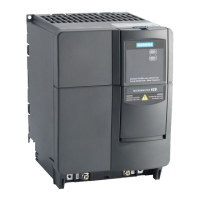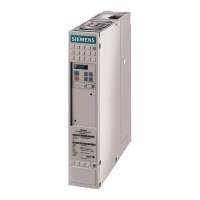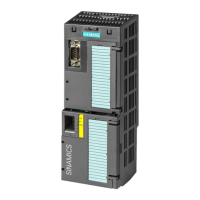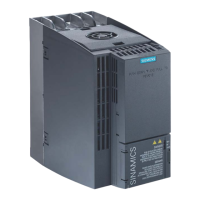Information for the CANopen master Issue 01/05
CANopen Option Module Operating Instructions
80 6SE6400-5BC00-0BP0
Table 5-1 Parameterizing the communications module using parameter
(object 27F9*)
MICRO-
MASTER
Para-
meter
Content Comment
420/430 440
2041.00 Low Byte =
Transmission
Type for
T_PDO_1
High Byte =
Transmission
Type for
T_PDO_5
Transmission Type for T_PDO_1 and T_PDO_5
See Table 5-2 for definition of Transmission Type.
Example. T_PDO_1 must be transmitted asynchronously. T_PDO_5
must be transmitted cyclically and synchronously every sync pulse.
High byte = 1H, Low byte = FFH
Convert 1FFH to decimal = 511
Enter 511 into P2041.00
Example setup :
2041.00 = 65535
T_PDO_1 = 255
T_PDO_5 = 255
X X
2041.01 Low Byte =
Transmission
Type for
T_PDO_6
High Byte =
Transmission
Type for
R_PDO_1,
R_PDO_5 and
R_PDO_6
Transmission Type for T_PDO_6 and R_PDO_1, R_PDO_5 and
R_PDO_6
See Table 5-2 for definition of Transmission Type.
Transmission Type for T_PDO_6 has the same definition as the
Transmission Types described in 2041.00.
Transmission Type for R_PDO_1, R_PDO_5 and R_PDO_6:
Note that for a node receiving a PDO, it is only necessary to know
whether the received PDO data is transferred immediately to the
Drive (asynchronous transfer), or whether the PDO is transferred to
the Drive on the next sync pulse (synchronous transfer). For this
reason for most efficient parameter storage the Transmission Types
for R_PDO_1, R_PDO_5 and R_PDO_6 are stored as single bits:
Bit 8 = 0 means R_PDO_1 is asynchronous and 255 is stored as
the Transmission Type for R_PDO_1
Bit 8 = 1 means R_PDO_1 is synchronous and 0 is stored as the
Transmission Type for R_PDO_1
Bit 9 = 0 means R_PDO_5 is asynchronous and 255 is stored as
the Transmission Type for R_PDO_5
Bit 9 = 1 means R_PDO_5 is synchronous and 0 is stored as the
Transmission Type for R_PDO_5
Bit 10 = 0 means R_PDO_6 is asynchronous and 255 is Stored as
the Transmission Type for R_PDO_6
Bit 10 = 1 means R_PDO_6 is asynchronous and 255 is Stored as
the Transmission Type for R_PDO_6
Note that a CANopen configurator can change the values for the
R_PDO_1, R_PDO_5 and R_PDO_6 Transmission Types to
anything within the allowable range, but only one bit will be used
within the Drive to store this information for each R_PDO. After a
power cycle, because only one bit is used for each R_PDO
Transmission Type, the R_PDO Transmission Types will be set to
either 255 (asynchronous) or 0 (synchronous) and the configurator
can write in the exact values if required. However, note that as far as
a CANopen slave is concerned, it is only necessary to know whether
the R_PDO is synchronous or asynchronous and overwriting by the
CANopen configurator with exact values of Transmission Type is not
really necessary.
Example setup:
2041.01 = 2047
T_PDO_6 = 255
R_PDO_1 = asynchronous = 255
R_PDO_5 = asynchronous = 255
R_PDO_6 = asynchronous = 255
X X
